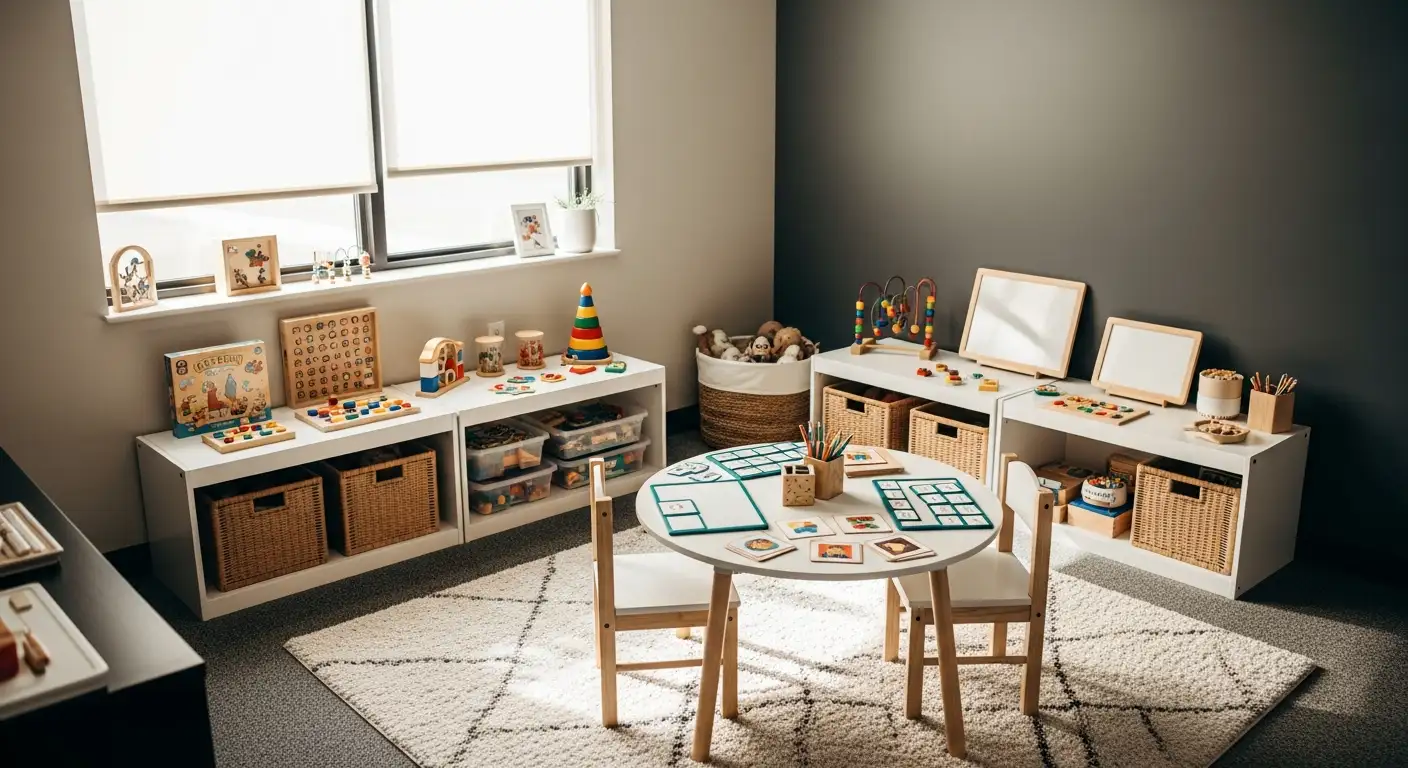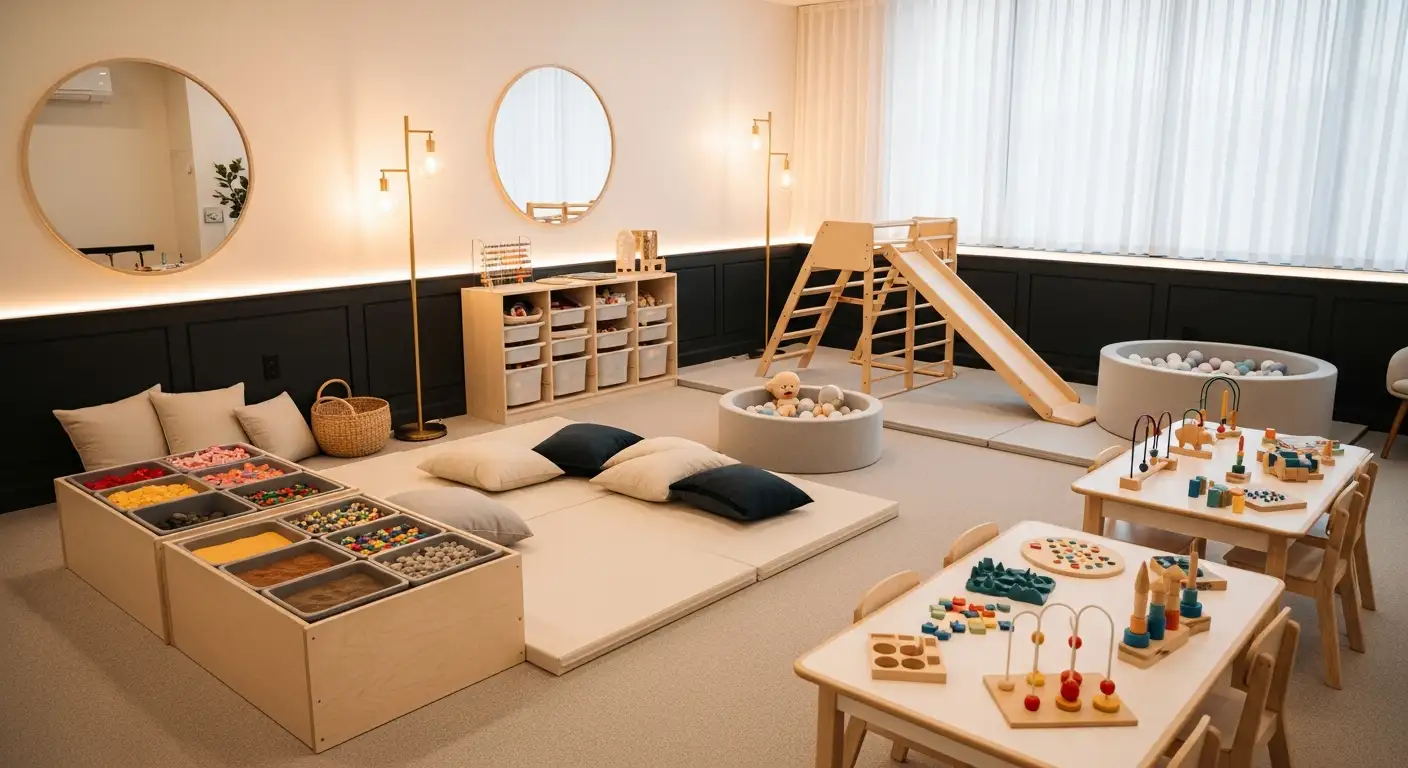The Connection Between Sensory Integration and Occupational Therapy


Understanding the Foundation of Sensory Processing and Occupational Therapy
Sensory integration (SI) forms a crucial bridge connecting the neurological processing of sensory input to effective behavioral and motor responses. Developed by Dr. A. Jean Ayres in the 1970s, this framework emphasizes how the nervous system organizes sensory information from various modalities—such as tactile, vestibular, proprioceptive, visual, and auditory—to support learning, behavior, and participation in daily activities. Occupational therapy (OT) leverages this understanding by implementing interventions tailored to improve sensory processing, thereby enhancing functional independence and quality of life for individuals with sensory processing challenges.
The Foundations of Sensory Integration and Its Application in Occupational Therapy

What is sensory integration, and how is it applied in occupational therapy?
Sensory integration (SI) is a brain-based process that involves organizing and interpreting input received from the environment and the body's own sensory systems. This process allows individuals to respond appropriately to sensory stimuli, supporting effective interaction with their surroundings.
Developed initially by Dr. A. Jean Ayres in the 1970s, SI emphasizes the importance of how sensory information from various systems—such as tactile, vestibular, proprioceptive, auditory, and visual—works together to facilitate adaptive responses. In a typical functioning brain, these sensory inputs are seamlessly integrated, enabling smooth motor responses, emotional regulation, and learning.
In occupational therapy, SI is applied through tailored, play-based activities aimed at improving the way individuals process and respond to sensory stimuli. Therapists design interventions using specialized equipment like swings, weighted vests, and tactile toys within controlled environments known as sensory gyms or therapy rooms.
The goal is to help children and adults with sensory processing issues develop more automatic and appropriate responses to sensory experiences. This can include activities like swinging, bouncing, or brushing, which provide controlled sensory input to help modulate arousal levels.
Assessment tools such as the Sensory Profile and the Sensory Integration and Praxis Test (SIPT) are used to evaluate sensory processing abilities. These assessments assist therapists in identifying specific sensitivities and designing effective intervention plans.
Sensory integration therapy (SIT), a primary intervention within occupational therapy, uses these activities to promote neural plasticity—the brain's ability to reorganize itself—encouraging functional improvements. Evidence suggests that, through consistent practice, SI-based interventions can foster changes in neural pathways, thereby improving behaviors, coordination, attention, and emotional regulation.
By addressing sensory processing difficulties, SI helps individuals achieve better participation in daily routines, from self-care and academic activities to social interactions. As a result, occupational therapy incorporating sensory integration plays a vital role in supporting the development, independence, and overall well-being of individuals with sensory challenges.
The Sensory Integration Frame of Reference: Theory and Practice

What is the sensory integration frame of reference in occupational therapy?
The sensory integration (SI) frame of reference in occupational therapy is a foundational theoretical approach that explains how the nervous system processes sensory input and uses this information to support functional behaviors and learning. It was developed by Dr. A. Jean Ayres in the 1960s based on her research into how sensory experiences influence development and behavior.
This framework emphasizes the importance of how the brain organizes sensory information gathered from multiple systems—such as hearing (auditory), sight (visual), touch (tactile), balance (vestibular), and body awareness (proprioception)—to enable children and adults to respond effectively to their environment.
Core principles of the SI frame of reference include the understanding that sensory modulation, discrimination, postural control, praxis (the ability to plan and execute movements), and bilateral integration are critical to adaptive functioning. Sensory modulation involves regulating responses to sensory stimuli; discrimination refers to the ability to differentiate between different sensory inputs; and praxis is about planning and coordinating movements.
Dysfunctions in these areas can manifest as behavioral challenges, emotional dysregulation, motor difficulties, or learning disabilities, particularly in children with autism spectrum disorder (ASD). For instance, some children may be oversensitive to sounds or textures, while others might be under-responsive, seeking excessive stimulation.
Occupational therapy within this framework employs structured, play-based activities designed to provide sensory input that enhances neural connections and promotes neuroplasticity—the brain's ability to change and adapt. Therapies often involve use of specialized equipment like swings, ball pits, weighted vests, brushing protocols, and sensory rooms—often called sensory gyms—to create controlled yet stimulating environments.
The ultimate goal of SI-based interventions is to improve how individuals process sensory information, leading to better self-regulation, more appropriate behavioral responses, and increased participation in everyday activities such as classroom learning, self-care, and social interactions.
How does the framework explain sensory processing difficulties?
The SI framework explains that when sensory signals are not integrated properly, it can cause challenges in everyday functioning. If a child's nervous system cannot accurately modulate or discriminate between sensory inputs, they may react too strongly (hypersensitivity) or too weakly (hyposensitivity) to stimuli. This can lead to behaviors like sensory seeking (e.g., spinning, banging objects) or sensory avoidance (e.g., covering ears, avoiding busy environments).
Such difficulties affect many domains, including emotional regulation, motor coordination, attention, and social development. For example, a child overwhelmed by loud noises may have a meltdown, or one who avoids touching certain textures could struggle with handwriting or dressing.
Impairments in sensory processing are common in developmental conditions like autism spectrum disorder, with up to 95% of children experiencing some form of sensory challenge. Recognizing these issues through assessments helps therapists develop targeted interventions that aim to recalibrate the child's sensory responses.
The significance of sensory modulation, discrimination, and praxis in OT
Sensory modulation, discrimination, and praxis are vital components in understanding and improving sensory processing abilities.
Sensory Modulation involves the capacity to regulate the level and intensity of sensory responses—being able to stay calm or alert as needed. Effective modulation is essential for focusing attention, managing emotions, and participating in routines.
Sensory Discrimination is the skill to distinguish between different sensory stimuli, such as recognizing the difference between textures or identifying sounds. Difficulties here can impair learning and daily tasks.
Praxis refers to the ability to conceive, plan, and carry out purposeful movements. It is fundamental for tasks like handwriting, dressing, and coordination.
Occupational therapy interventions strive to improve these abilities through activities that strengthen the neural pathways involved. For example, controlled swinging or spinning can help enhance vestibular processing; tactile play can improve discrimination; and combined sensory-motor tasks support praxis development.
By addressing these interconnected areas, occupational therapy aims to foster self-regulation, enhances motor and cognitive skills, and promotes independence. In turn, this improves participation in school, home, and community settings, ultimately supporting children in reaching their full potential and leading more adaptable, confident lives.
Techniques and Interventions: Practical Approaches in Sensory Integration Therapy

What are some techniques used in sensory integration therapy?
Sensory integration therapy employs a broad array of methods designed to help the brain better process and respond to sensory information. These techniques are tailored to each individual's sensory profile and often involve play-based activities that are both engaging and therapeutic.
One common approach includes swinging, bouncing, and spinning activities. These vestibular stimuli help improve balance, coordination, and spatial awareness. Therapists often use swings, ball pits, and spinning bowls to provide controlled vestibular input, which can be calming or alerting, depending on the child's needs.
Tactile stimulation plays a crucial role and is achieved through brushing protocols, textured materials, and tactile exploration activities. For example, the Wilbarger brushing technique involves light brushing of the skin with a soft-bristled brush to desensitize or desensitize tactile hypersensitivity, often combined with joint compressions for proprioceptive input.
Proprioceptive inputs, essential for body awareness and muscle tone regulation, are provided through activities like weighted vest wearing, resistance exercises, and pushing or pulling objects. Using weighted blankets or squeeze machines also offers deep pressure stimulation that can promote calmness and focus.
Auditory and visual systems are targeted with sound filtering tasks—such as listening to calming music or noises—and visual activities like puzzles or tracking exercises that help strengthen sensory discrimination and processing capabilities.
Beyond these, olfactory and gustatory exercises, including scent jars and taste exploration activities, engage the smell and taste senses, which can assist in calming overresponsive or underresponsive children.
Each technique aims at progressively helping children develop the ability to organize sensory inputs effectively, leading to improved behavior, emotional regulation, and functional skills.
Use of equipment like weighted vests and sensory gyms
Integral to sensory integration therapy are specialized equipment and environments called sensory gyms. These setups are filled with tools that provide various sensory experiences in a safe, structured manner.
Weighted vests are frequently used to offer calming proprioceptive input. The added weight stimulates the body’s sense of touch and pressure, helping children feel more grounded and less overwhelmed by external stimuli.
Sensory gyms feature equipment like swings, slides, ball pits, foam blocks, tactile boards, and textured surfaces. The variety of sensory experiences promoted in these spaces fosters neural connections and supports the child's sensory modulation abilities.
Technologies may include visual stimulation tools like spinning disks or LED lights, auditory equipment such as headphones with filtered sounds, and tactile surfaces that are soft, rough, or textured, depending on therapeutic goals.
These environments are usually designed to be engaging, playful, and safe, enabling children to explore, practice motor skills, and improve sensory processing through targeted activities.
Tailoring interventions to individual sensory profiles
Effective sensory integration therapy must be personalized to suit each child’s unique sensory sensitivities and processing difficulties. Occupational therapists conduct comprehensive evaluations, including observations, caregiver interviews, and standardized assessments like the Sensory Profile.
Based on these assessments, therapists develop individualized sensory diets—structured schedules of sensory activities—that aim to modulate arousal levels and improve daily functioning.
For example, a child with sensory seeking behaviors may benefit from activities that provide proprioceptive and vestibular input, such as bouncing or swinging. Conversely, a child who is overly sensitive may require calming tactile activities or controlled exposure to sensory stimuli.
These interventions are continuously monitored and adjusted, ensuring they are appropriate and effective. Such personalized approaches maximize the potential for improving sensory processing, emotional regulation, and participation in everyday activities like school, play, and social interactions.
Evidence Base and Research Supporting Sensory Integration in OT
What is the sensory integration theory in occupational therapy?
Sensory integration theory, pioneered by Dr. A. Jean Ayres in the 1970s, offers a comprehensive framework for understanding how the nervous system processes and organizes sensory input. It involves multiple sensory systems, including vestibular (balance and movement), tactile (touch), proprioceptive (body position), visual, and auditory inputs. The core idea is that these sensory signals are integrated within the brain to produce adaptive responses necessary for everyday functioning.
This theory emphasizes that children can learn to respond more appropriately to sensory stimuli through targeted activities. These interventions are often play-based and designed to promote sensory regulation and integration, ultimately enhancing behaviors, learning, and development. For instance, children with sensory processing difficulties might experience tactile defensiveness or balance issues, which can hinder their performance in school or daily activities.
Occupational therapists utilize the principles of sensory integration to assess and remediate these difficulties. The approach highlights neural plasticity—the brain's ability to change—to improve sensory processing and behavioral responses. It provides a structured way to evaluate sensory processing challenges and develop therapeutic activities that foster neural organization and functional improvements.
Overall, sensory integration theory underpins many therapeutic strategies aimed at helping children overcome sensory-related challenges, supporting their growth in areas like motor skills, emotional regulation, and cognitive development.
Implementing Sensory Integration in Children’s Occupational Therapy Settings

How does occupational therapy address sensory processing challenges in pediatric populations?
Occupational therapy plays a crucial role in helping children manage sensory processing challenges by utilizing comprehensive evaluations and personalized intervention strategies. Therapists typically begin by assessing sensory deficits through interviews with caregivers, behavioral observations, and standardized tools such as the Sensory Profile and the Sensory Integration and Praxis Test (SIPT). This thorough assessment helps identify specific sensitivities or deficiencies across sensory systems, including tactile, vestibular, proprioceptive, auditory, and visual modalities.
Once assessments are completed, therapists develop tailored intervention plans that incorporate evidence-based strategies. A common approach involves sensory-rich play activities designed to stimulate and organize sensory input. These activities might include swinging, water play, obstacle courses, or the use of specialized equipment like trampolines, weighted vests, and balance beams, often conducted in sensory gyms. These environments are structured to provide controlled sensory experiences that help children improve their sensory modulation and integration.
An essential component of intervention is the creation of sensory diets—customized routines of sensory activities scheduled throughout the day. Sensory diets are designed to help children achieve an optimal level of arousal, enabling better attention, emotional regulation, and participation in everyday activities such as dressing, play, and academic tasks.
In addition to direct therapy, occupational therapists emphasize collaboration with families and educational staff. Caregivers and teachers are trained to incorporate sensory strategies into daily routines, whether at home or in school settings. This might involve establishing quiet spaces, using weighted blankets, or providing fidget toys to help children self-regulate.
Furthermore, occupational therapists advocate for environmental modifications in classrooms and homes that minimize sensory overloads or provide appropriate stimulation. These modifications can greatly reduce behavioral issues and support children's developmental progress in social, motor, and emotional domains.
Overall, occupational therapy's multifaceted approach helps children with sensory processing challenges develop better self-regulation, improve motor coordination, and enhance their overall ability to participate actively in daily life.
Bringing It All Together for Enhanced Therapeutic Outcomes
The integration of sensory processing principles into occupational therapy practice provides a powerful framework for addressing the sensory and developmental needs of children with various challenges. By applying structured, evidence-based interventions rooted in the sensory integration theory and utilizing specialized techniques and tools, occupational therapists facilitate neuroplastic changes that support better regulation, motor skills, and participation in daily and educational activities. As ongoing research continues to refine these methodologies, the collaboration among therapists, families, and educational environments remains central to optimizing outcomes. Emphasizing the importance of tailored assessments and individualized treatment plans, sensory integration remains a cornerstone of modern occupational therapy practices aimed at fostering independence and improving quality of life.
References
- Sensory Integration - StatPearls - NCBI Bookshelf
- Sensory Integration Frame of Reference - OT Theory
- How Can Occupational Therapy Help with Sensory Issues?
- Sensory Integration and Occupational Therapy - The SMILE Center
- Sensory Integration Therapy | Treatment | Services - OT for Kids
- Treating Sensory Processing Issues - Child Mind Institute
- Occupational Therapy Interventions for Children and Youth With ...
- Occupational Therapy Benefits Children with Sensory Integration ...
- Sensory Integration Therapy - HealthyChildren.org
Recent articles

Expressive Speech Delay 2-Year-Old
Understanding and Addressing Expressive Speech Delay in Toddlers

How Speech Recognition Works
Unlocking the Power of Speech Recognition in Therapy and Healthcare

Autism and Head Size
Understanding the Complex Relationship Between Autism and Head Size

Occupational Therapy in Autism
Enhancing Independence and Quality of Life Through Occupational Therapy in Autism

Do Autistic People Understand Sarcasm?
Navigating the Nuances: Understanding Sarcasm and Social Communication in Autism

Autism Routines
Crafting Effective Daily Structures for Children with Autism

